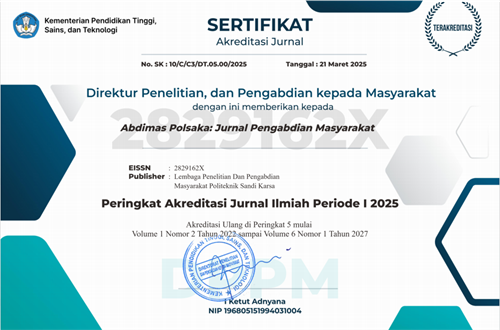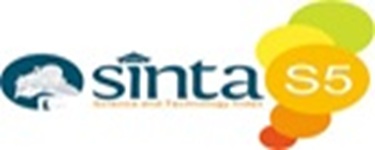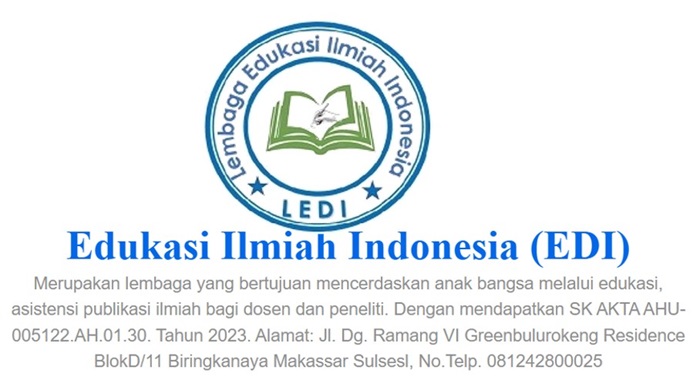Author Guidelines
Please use the following guidelines to prepare your manuscript before submitting it.
Heading
Title, Times New Roman typeface, Size 14, Capital, left-aligned
Author1, Author2, Author3, etc. (Full name, not abbreviated, and does not use a size 12 title)
1) Institution, Region, email.
2) Institution, Region, email.
3) Institution, Region, email. font size 11)
Corresponding Author: First Author font size 11)
Abstract: Abstract are written in Indonesian and English and contain 150-200 words in one paragraph. Contains a brief description of the overall research results including the background of the problem, objectives, methods, results and conclusions. Avoid writing citations, and abbreviations in the abstract. The writing uses Times New Roman font size 12, spaced 1, for Abstract in English with italic font format.
Keywords: Consists of 3-5 keywords, keyword 1, keyword 2, etc.
Abstract: Abstract is written in Indonesian and English and contains 150-200 words in a single paragraph. Contains a brief overview of the overall research results including the background of the problem, objectives, methods, results and conclusions. Avoid writing quotes, and abbreviations in abstracts. Writing using Times New Roman font size 12, space 1, for English Abstract with italic letter format.
Keywords: Consists of 3-5 keywords, keyword 1, keyword 2, etc.
Manuscript Structure
The article must contain writings that contain, 1) Introduction, 2) Research Methods (can include analysis, architecture, methods used to solve problems, implementation), 3) Results and Discussion, 4) Conclusion, 5) Acknowledgments (if any) and References. The text uses Times New Roman in size 12 bold letters.
INTRODUCTION
The introduction includes a concise, clear, and concise research background; research objectives; and supporting theories. Written using Times New Roman letters size 12, space 1.15. Writing in foreign languages in italics. Narrative writing does not need to be given special subtitles. This includes writing operational definitions, if necessary, a written narrative is also necessary. All forms of reference used must be written at the source. Writing citations or references using body notes is by writing the author's last name and year of writing written in parentheses (Muthmainnah, 2017).
METHOD
The method contains the implementation of Service and other matters related to the method of research. This section can be divided into sub chapters, but there is no need to list the numbering.
RESULTS AND DISCUSSION
The results are presented systematically, written without sub-chapters and written in full first, then the author writes the results of the discussion. The results of the narrative contain information taken from the data that does not tell the truth as it is, but tells the meaning of the data or information. For the purpose of clarifying information, authors can add tables, figures, etc. In addition, the results also present the items listed in the research objectives or the results of the hypothesis test proposed along with each step taken for the test as written in the method section.
The discussion suggests the interpretation of the results, the development of arguments by connecting the results, theories, and opinions, including comparisons with the results of previous research. It is also important to increase the possibility of contributing the results of their research to the development of science. This section does not rewrite the data from the study.
Table
For tables, the table description is placed at the top of the table. Information is written on the left with space 1, the space of the table. Like the description of the figure, the information table is also given a sequence number. The table source writing is placed below the table and is aligned with the left margin of the table to the Times New Roman 10 size. Writing on the table is typed with a space of 1. The lines of the table are only horizontal lines while the vertical lines are removed.
Picture
The picture is placed in the center and referenced in line with text. The caption of the picture is written under the picture with a number. The caption of the image begins with a capital letter. If the caption of the image is more than 1 line, then it is written with 1 space. If the picture is a reference, then the source of the reference is also written. The source of the image reference is typed with Times New Roman letters size 10.
CONCLUSION
The conclusion answers the purpose of the problem or study based on a more comprehensive understanding of the results and discussion of the research. Suggestions are intended for practical action (to participating institutions), for the development of new theories, and for further research.
REFERENCE
REFERENCES In-Text Citation Format: References are simply cited with the consistent reference number in square brackets. Do not set reference numbers as superscript numbers. Do not use "Ref. [3]" or "Reference [3]" except at the beginning of a sentence, e.g,. "Reference [3] shows …"
Single Reference: If the author's name appears in the text, place the reference number immediately after the name. E.g., "Peter [10] found an innovative scientific phenomenon."
Multiple References: When citing multiple references, list the numbers in numerical order, separated by commas with no spaces. For example: [2,3] or [2], [3]. To indicate three or more consecutive references, use the following formats: [1], [3], [5]; [1]–[5] or [1, 3, 5]; [1–5].
List of REFERENCES: Authors are requested to ensure that all references are complete and accurate. Each entry should include the full list of authors, title of the paper, journal name, volume, issue number, page range, year of publication, and DOI (or URL if available). Please note that if both DOI and URL are provided, the DOI should appear after the URL and end with a period. This journal uses the IEEE reference style. Please format all references accordingly. For detailed guidance, refer to the official IEEE Reference Guide here.
















